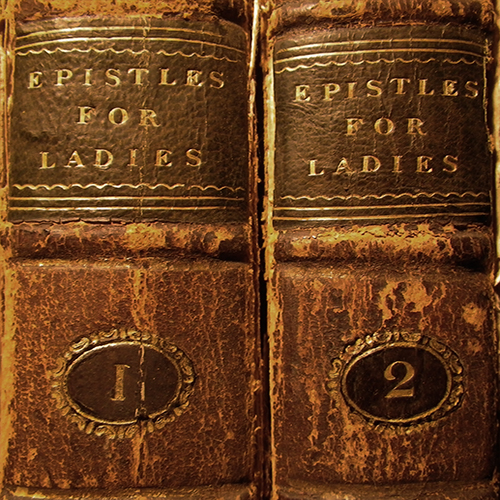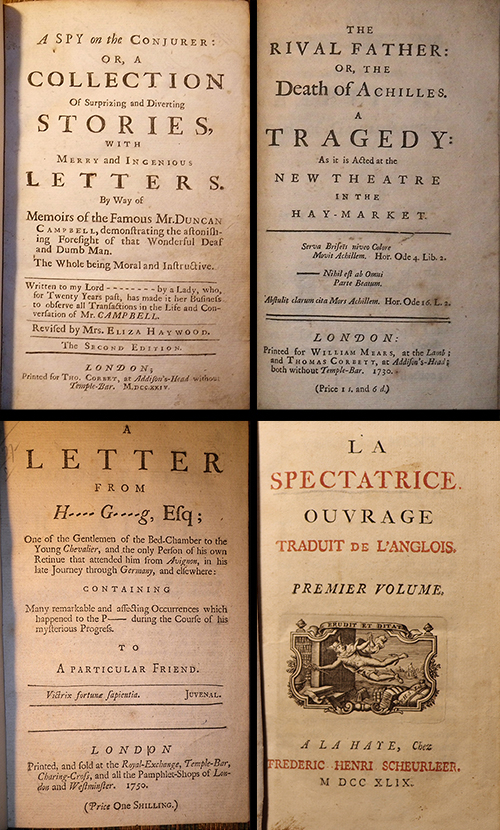Although 2021 was not much of an improvement on 2020 in Covid-terms—endless lock-downs, working from home etc.—it was a significant improvement in terms of book-collecting. I have no grand theory to explain why, and it may be that I was mistaken in the explanation I offered (here) for the 18C book-drought of 2020. Whatever the reason, 2021 brought three times as much Haywoodiana to my door as 2020—and most of these items were much more interesting too.
One of the most interesting arrived yesterday. Like David Levy, the shipping of a late-2021 purchase was delayed to an extraordinary extent due to “the resurgent pandemic” (here). Having paid a hundred dollars (!!) for 2–5 day international delivery—for an item that could have been slipped into a small Christmas card—my parcel took two months to appear: with two multi-week periods in which tracking reported no movement whatever, leaving me despairing that it may have been lost.
I have been waiting for the arrival of this parcel to post a “collecting year in review”; and since my parcel should have arrived in November, I am going to pretend that it did arrive in 2021 and am including it here. As a result, I am also including everything else that arrived between my "Collecting Haywood, 2020" post, and now.
As you can see above, my long-delayed parcel contained a dated signature, taken from a letter written by the poet, sometime-friend and sometime-enemy of Haywood, Richard Savage, on 12 July 1743, less than 3 weeks before he died in Bristol Newgate Prison. I believe that this may be the last datable piece of writing in Savage’s hand—not that Savage manuscripts are exactly common. Clarence Tracey quotes from 27 letters in his biography of Savage, but most of them are from printed sources.
As I was waiting for this scrap of paper to arrive, I obtained copies of a few other examples of Savage’s writing—enough to convinced me of the authenticity of the writing, and of the attribution to “Dr. Johnson’s Richard Savage as opposed to, say, Robert Savage, sausage-maker” (as Stuart Bennett quipped). I did not expect to start collecting detached signatures in this way, but the dam broke with the acquisition in 2020 of three receipts from a signature collection—one signed by Hatchett.
One of the two greatest contributor to 2021 being a much better collecting year than 2020 was a lot of thirteen titles in nineteen volumes that I bought at Chroley’s Spetchley Park Auction in late March. Fortunately for me, the Spetchley Park Auctions—and the presence of a Haywood item—received some news coverage, and so I was alerted to the sale (background here; the actual article here). The Haywood item reported on in the news turned out to be two Haywood items listed in the description of the lot (above; both of which I had), which turned out to be three Haywood items once the lot arrived in Melbourne: Ab.70.4 The Wife, 3rd ed., Ab.72.1 The Husband and Ab.64.3 Epistles for Ladies, 3rd ed. 2 vols.—this last one being the surprise inclusion, and one that I did not have (below).
The ten other Spetchley Park items all either works by women, or relating to women, many of which I had long wanted: Aphra Behn’s Love-Letters between a Nobleman and his Sister, Jane Collier’s, An Essay on the Art of Ingeniously Tormenting, Steele’s The Ladies Library, Salmon’s A Critical Essay Concerning Marriage, Madan’s Thelyphthora; Or A Treatise on Female Ruin, Alexander’s The History of Women, from the earliest antiquity, and Hayley’s A Philosophical, Historical, and Moral Essay on Old Maids—among others.
I cannot say much about the second great contributor to 2021 being such a good Haywood collecting year, but I can say that I discovered a French translation of a work by Haywood that I had somehow previously missed. Said work was printed many times, and translated into three other languages. Since I am in the midst of sweeping the market clean of these translations, I don’t want to risk inflating the price of any books that remain outside of institutional collections until I have a decent sample of them. I have managed to buy copies of four editions so far. My examination of these suggests that the few bibliographers who have mention the work have missed a great deal indeed. Both the collecting, and unraveling the mystery, are proving to be immensely enjoyable.
Of the items not covered above, three are by Hatchett: with the help of Stuart Bennett I picked up a copy of Dd.1.1b The Adventures of Abdalla, 2nd ed.—in a very ugly binding, but with the full complement of plates—and I also managed to get two copies of one of his plays, Dd.4.1 The Rival Father Or The Death Of Achilles: A Tragedy. I was particularly pleased about this because both were in intact sammelbands from the one, very large and very interesting eighteenth-century collection of plays, the provenance of which I was able to untangle.
The remaining Haywood items includes two more copies of the first edition of The Female Spectator in French—one with a variant title-page which has, once again, thrown into doubt my arrangement of editions (my original “Ab.60.11” has already become Ab.60.11, Ab.60.11A and Ab.60.11B!). I also received my third NQR copy of Ab.58.9 New Present for a Servant Maid. This one lacks the frontispiece, but has the final leaf, which is missing in my only copy with the frontispiece. Cookery books are particularly hard to find in nice condition, and complete, but one day I hope to find one such unicorn.
Also NQR (not quite right) was a copy of Ab.66.2 A Letter from H---- G----g [Henry Goring]—the pirate edition. Seemingly from the collection of Gershon Legman, I discovered once it arrived that it was missing an entire gathering. Fortunately, the vendor gave me both a complete refund, and the book. I also picked up at various times duplicate odd volumes of The Invisible Spy, The Female Spectator, and Jemmy and Jenny Jessamy, of interest only to someone like me.
The remaining three items are all very nice: Haywood’s Ab.11.1c A Spy on the Conjurer, 2nd ed. (1724); Elizabeth Griffith’s A Collection of Novels, Selected and Revised, 3 vols. (1777), which contains Haywood’s Fruitless Enquiry—which is quite rare (ESTC records nine copies), and often incomplete; and Ac.10b Matrimonial Preceptor, 2nd ed. (1759), which contains excerpts from The Female Spectator.
This last one is a nice segue way into a post I plan to do shortly on unauthorized and previously unrecognized reprints of works by Haywood, but I am still on holidays, so that may be another month away. Until then, thank you to all my (patient) readers, who have put up with my long silences. I will make no resolutions for 2022, but do expect to post more than I did in 2021.
Sunday, 16 January 2022
Subscribe to:
Post Comments (Atom)






No comments:
Post a Comment